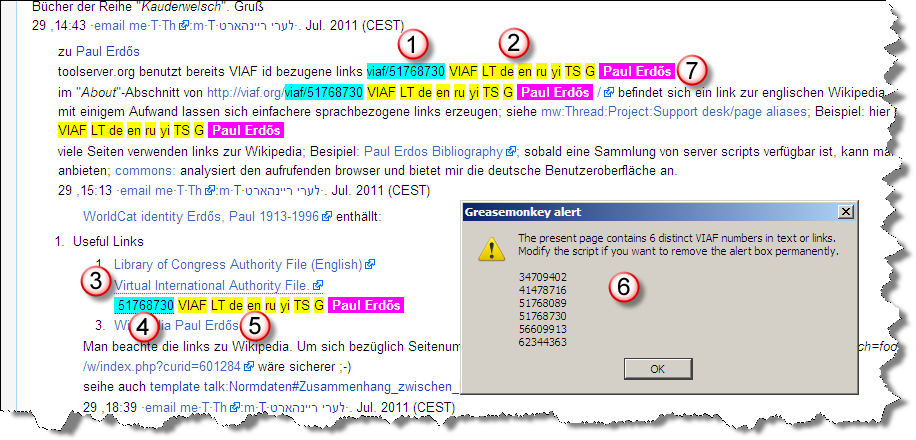Commons:VIAF inter project linking/Tools
Jump to navigation
Jump to search
Bookmarklet
[edit]- A bookmarklet is now available on the VIAF bookmarklet info page (the URL might change) as an alternative to the Greasemonkey script (described below). It has been tested working with Firefox 12, Chrome, and Internet Explorer 8.0, and it does not require Greasemonkey. --Wikinaut (talk) 07:03, 3 May 2012 (UTC)
- If you find bugs or want to file suggestions, please use the bugzilla bugtracker: Bugs: list open all report
Greasemonkey script
[edit]The Greasemonkey script is no longer maintained. Please use the bookmarklet version, which fixes many bugs and works in many browsers.
--Wikinaut (talk) 07:23, 29 April 2012 (UTC)
--Wikinaut (talk) 07:23, 29 April 2012 (UTC)
Both script variants highlight VIAF, PND and GND identifiers in web pages and looks up the identifiers on various websites known to publish information using these identifiers.
The Greasemonkey script requires Firefox and Greasemonkey. As an alternative, a bookmarklet for Chrome, Firefox and IE 8 is available since April 2012 (see above).
The Greasemonkey script can be downloaded from the MediaWiki software repository (SVN):
 Always check first whether the source code is unchanged. The script runs on every web page, which potentially is a risk with Greasemonkey scripts. Please use the script with care. You can consider to disable it after use.
Always check first whether the source code is unchanged. The script runs on every web page, which potentially is a risk with Greasemonkey scripts. Please use the script with care. You can consider to disable it after use.- current version 0.403
- check script source code
- download script: http://svn.wikimedia.org/svnroot/mediawiki/trunk/tools/viaf/viaf.user.js
Bookmarklet and Greasemonkey script description
[edit]Both scripts detect VIAF, PND and GND numbers on web pages and creates related links.
- They try to generously detect VIAF, PND and GND numbers as part of a web page's text, and also as part of links (urls). They also fetch corresponding names from the Toolserver.
- Detected numbers are indicated with bright cyan colour (1, 4) to attract the user's attention.
- While detecting the numbers, the scripts add new links to additional servers (2, 5). Such new links come in yellow and have the detected number as part of the url, i.e. are deep links (single-click solution).
- Those numbers (4) which are only part of a url (3) (i.e not in the text) are not apparent without running the script. Numbers as part of urls are treated in the same way as numbers in the text. The script adds a dotted red underline (3) to urls which contain a VIAF which is detected by matching a magic regular expression (see program code for details).
- A summary box (6) lists all distinct numbers to facilitate cut & paste of the extracted numbers; this can be disabled in the program code.
- The set of further server urls can be adapted in the program code.
- Both scripts rely on jQuery and two further javascripts, which are fetched automatically.
